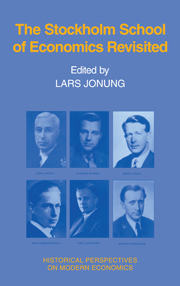Book contents
- Frontmatter
- Dedication
- Contents
- Preface
- List of Contributors
- Dramatis Personae at the end of 1937
- Introduction and Summary
- Part I The roots
- Part II The approach of the Stockholm School
- 4 Expectation and plan: The microeconomics of the Stockholm School
- 5 Sequence analysis and optimization
- 6 There were two Stockholm Schools
- 7 On formal dynamics: From Lundberg to chaos analysis
- Comment
- Comment
- 8 Lundberg, Keynes, and the riddles of a general theory
- 9 Macrodynamics and the Stockholm School
- 10 Ohlin and the General Theory
- 11 The monetary economics of the Stockholm School
- 12 The Austrians and the Stockholm School: Two failures in the development of modern macroeconomics?
- 13 The political arithmetics of the Stockholm School
- 14 After the Stockholm School
- Part III The impact of the Stockholm School
- Part IV What remains of the Stockholm School?
- The Stockholm School: A non-Swedish bibliography
Comment
Published online by Cambridge University Press: 05 July 2013
- Frontmatter
- Dedication
- Contents
- Preface
- List of Contributors
- Dramatis Personae at the end of 1937
- Introduction and Summary
- Part I The roots
- Part II The approach of the Stockholm School
- 4 Expectation and plan: The microeconomics of the Stockholm School
- 5 Sequence analysis and optimization
- 6 There were two Stockholm Schools
- 7 On formal dynamics: From Lundberg to chaos analysis
- Comment
- Comment
- 8 Lundberg, Keynes, and the riddles of a general theory
- 9 Macrodynamics and the Stockholm School
- 10 Ohlin and the General Theory
- 11 The monetary economics of the Stockholm School
- 12 The Austrians and the Stockholm School: Two failures in the development of modern macroeconomics?
- 13 The political arithmetics of the Stockholm School
- 14 After the Stockholm School
- Part III The impact of the Stockholm School
- Part IV What remains of the Stockholm School?
- The Stockholm School: A non-Swedish bibliography
Summary
In his paper, Baumol takes up the cudgels for the method of constructing an analysis based on numerical examples (using relevant values for the parameters of the dynamic equations). Numerical examples played an important role in theoretical economics in the early days, notably in the powerful writings of the classical economists Ricardo, Malthus, and Marx. Graphical and algebraic methods have subsequently dominated the field, permitting more general conclusions. For some time, reasoning from numerical examples has tended to be downgraded by conventional and occasionally arrogant critics who have degraded works in which the author did not deal with his model by analytical methods. However, why should one refrain from the possibility of gaining insight into the workings and results of a model for which we are unable to write down the general analytical solution? The question becomes, as Baumol stresses, all the more important at a time when computers greatly facilitate numerical explorations.
In the first part of his paper, Baumol describes and assesses, in an illuminative way, the “Lundberg approach” to dynamic analysis, that is, reasoning from numerical examples. In the two last sections on recent developments in economic dynamics and chaos theory, we learn how modern researchers revert to the step by step numerical calculation procedure laid out by Lundberg some fifty years ago. I find all this very interesting. My only critical comments concern the section “What Dynamic Models Can and Cannot be Expected to Accomplish.”
- Type
- Chapter
- Information
- The Stockholm School of Economics Revisited , pp. 198 - 200Publisher: Cambridge University PressPrint publication year: 1991

